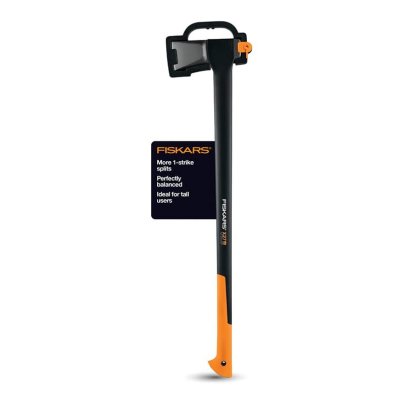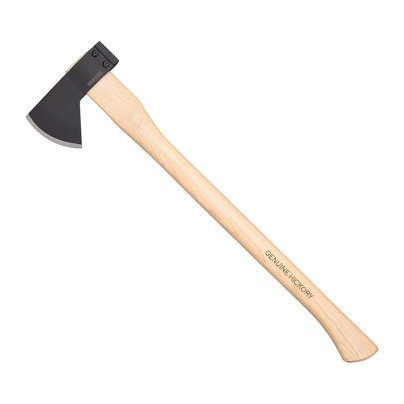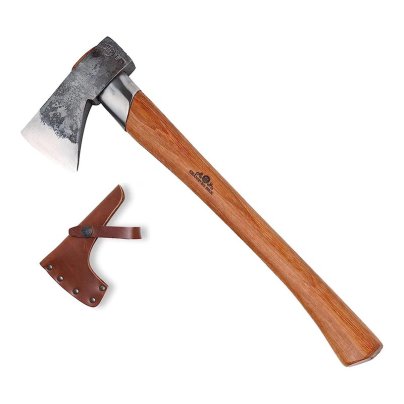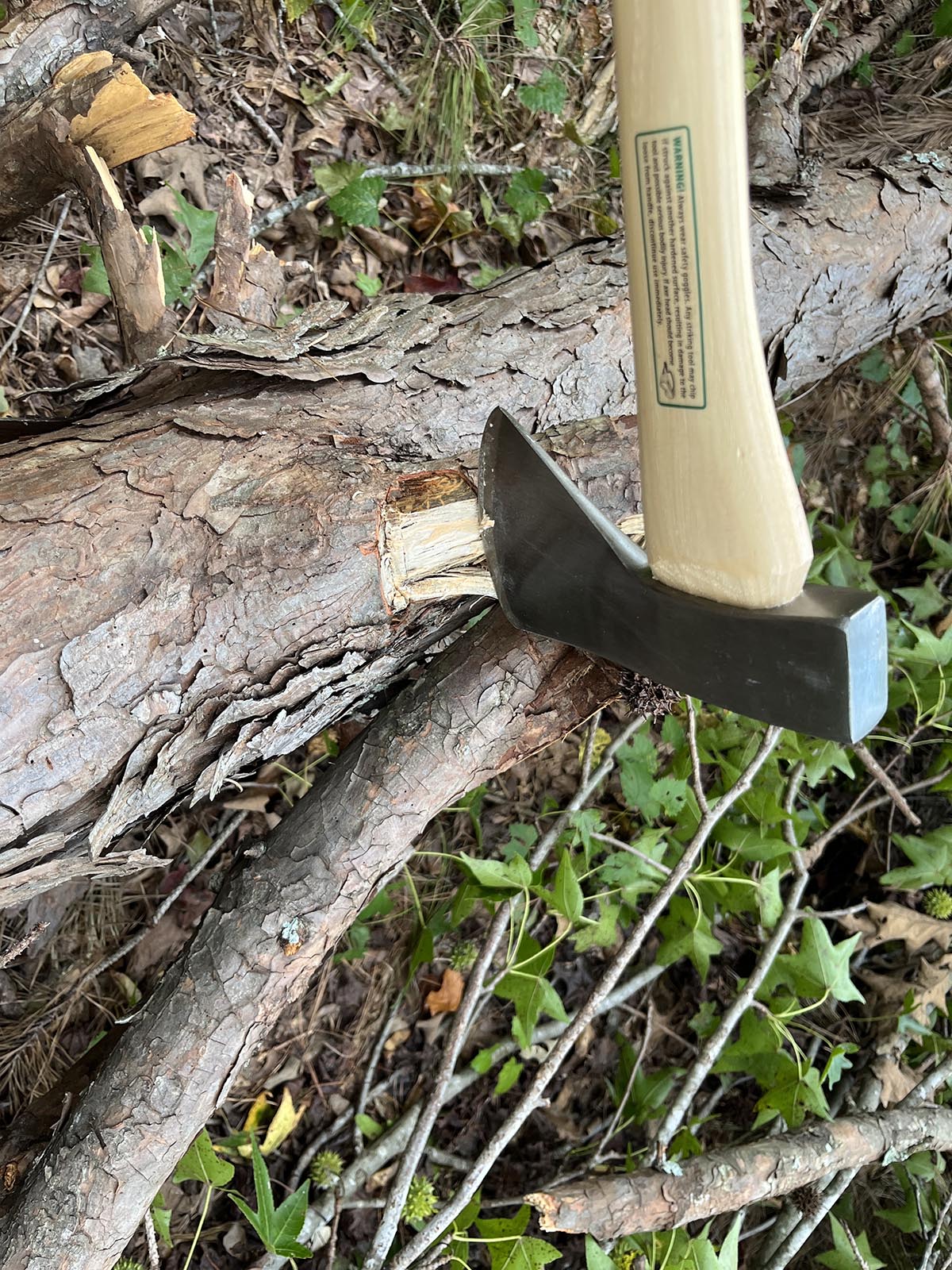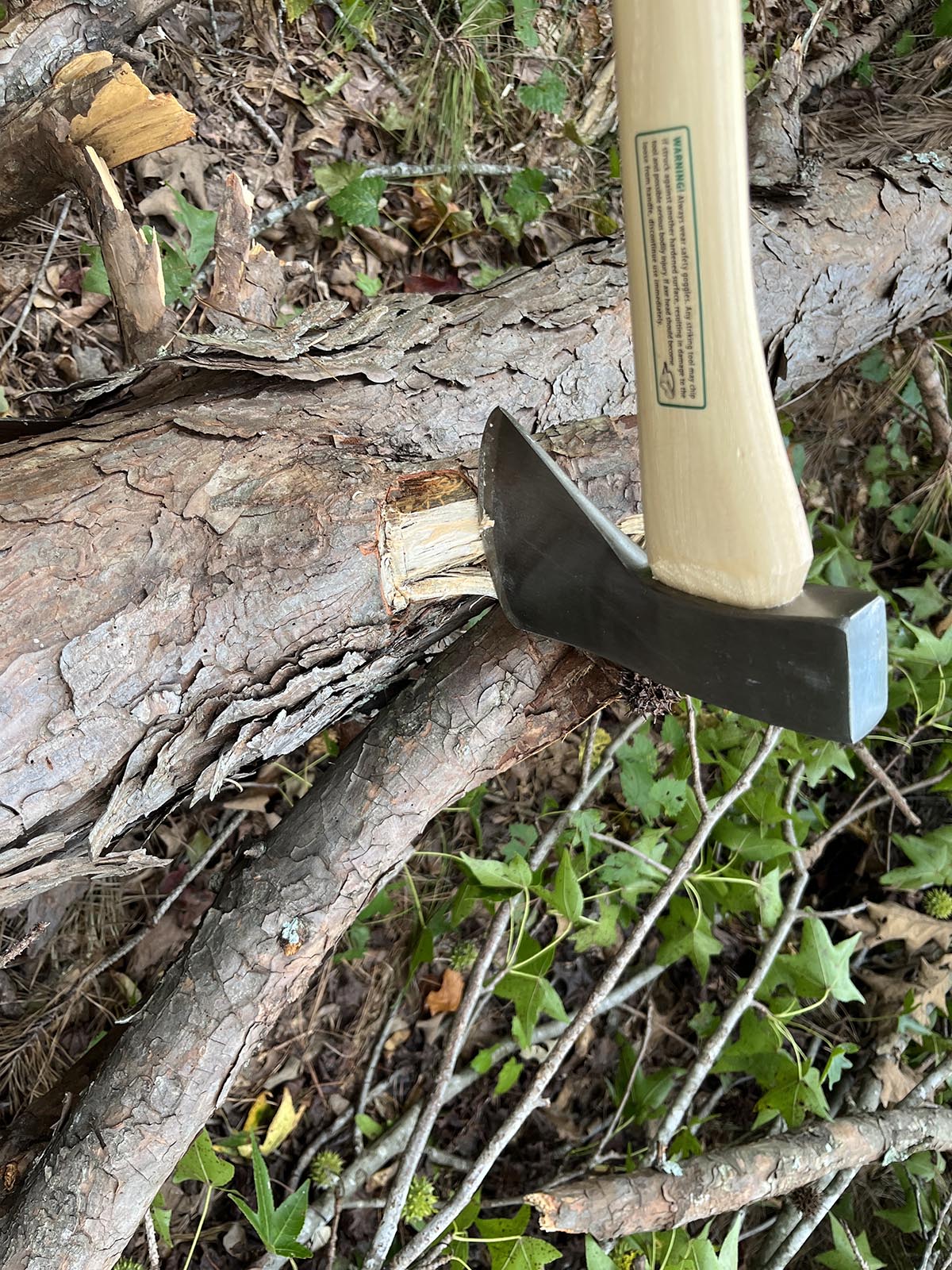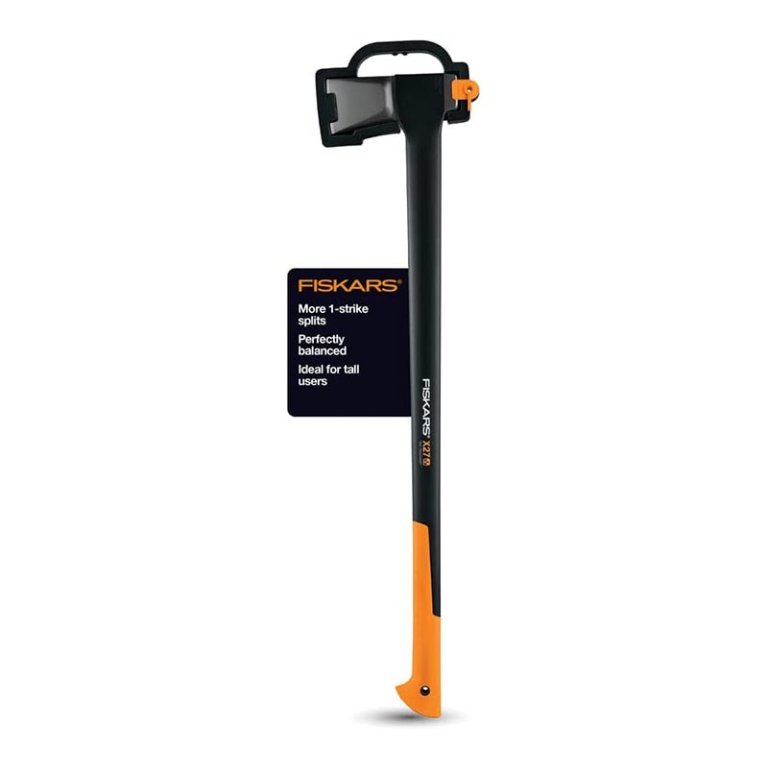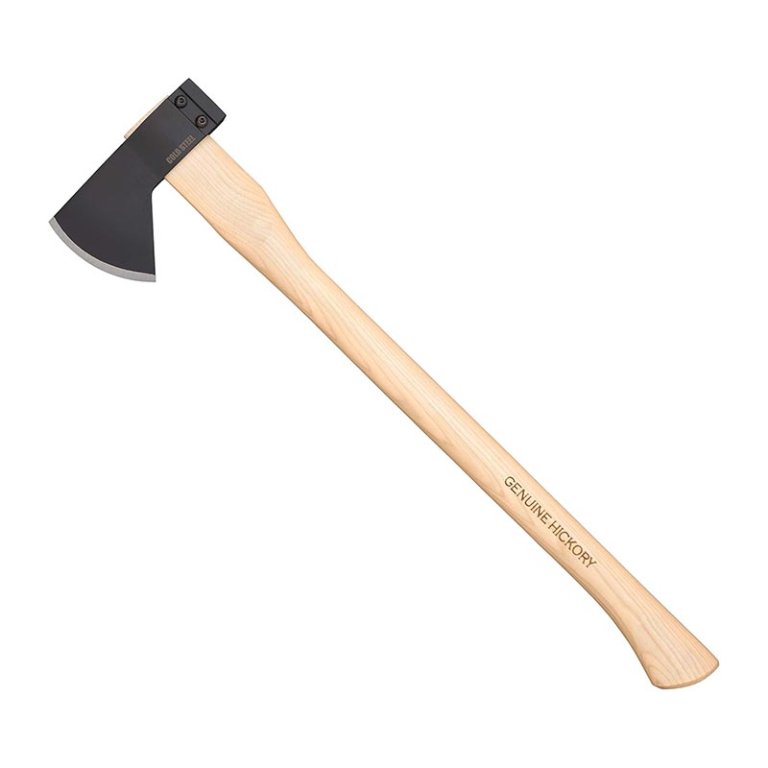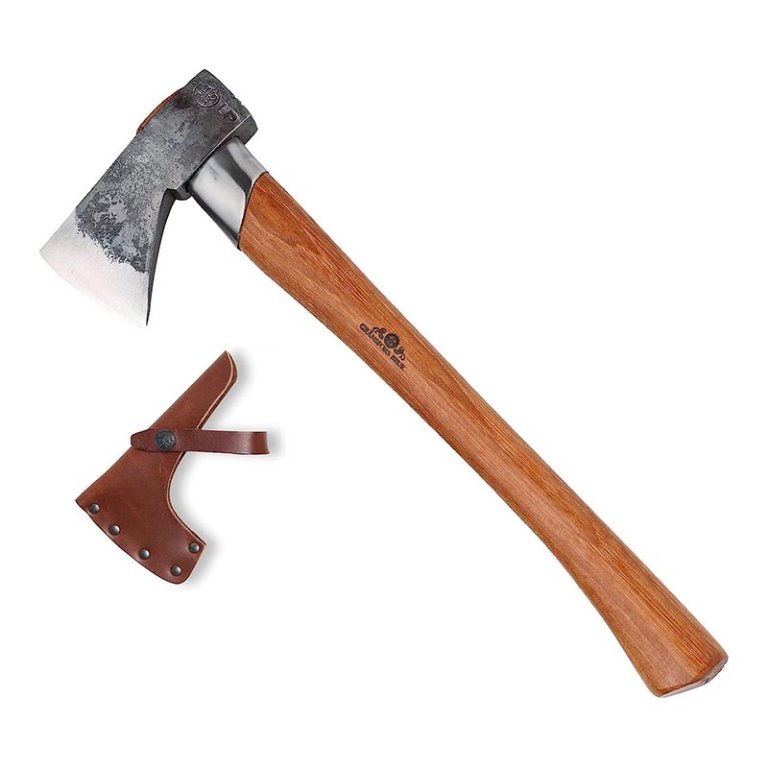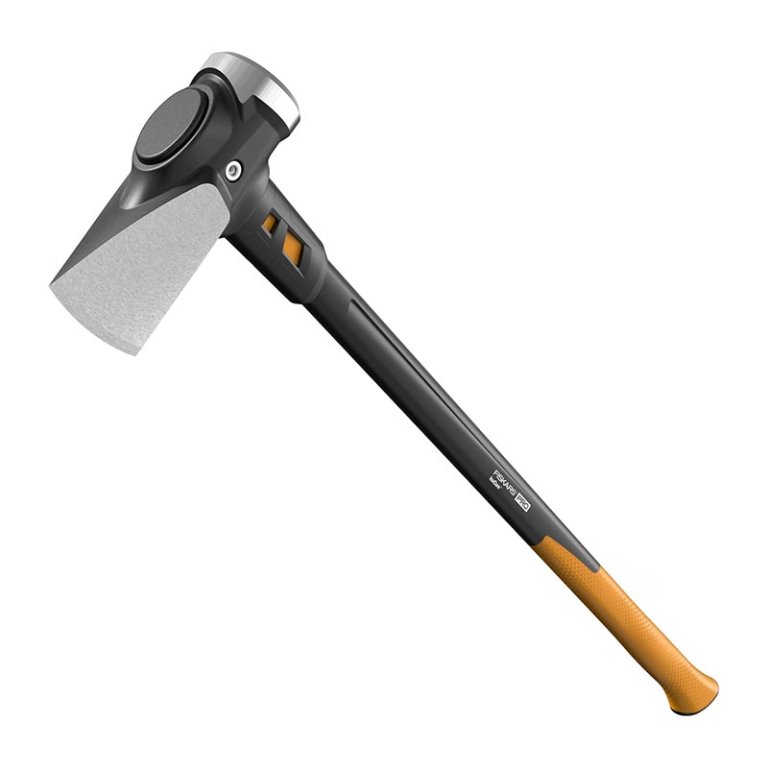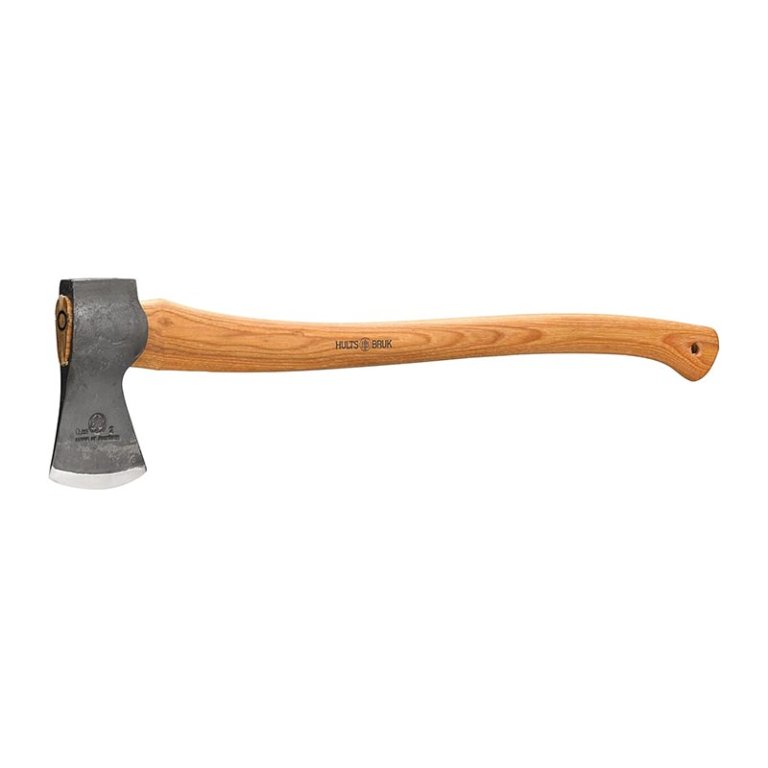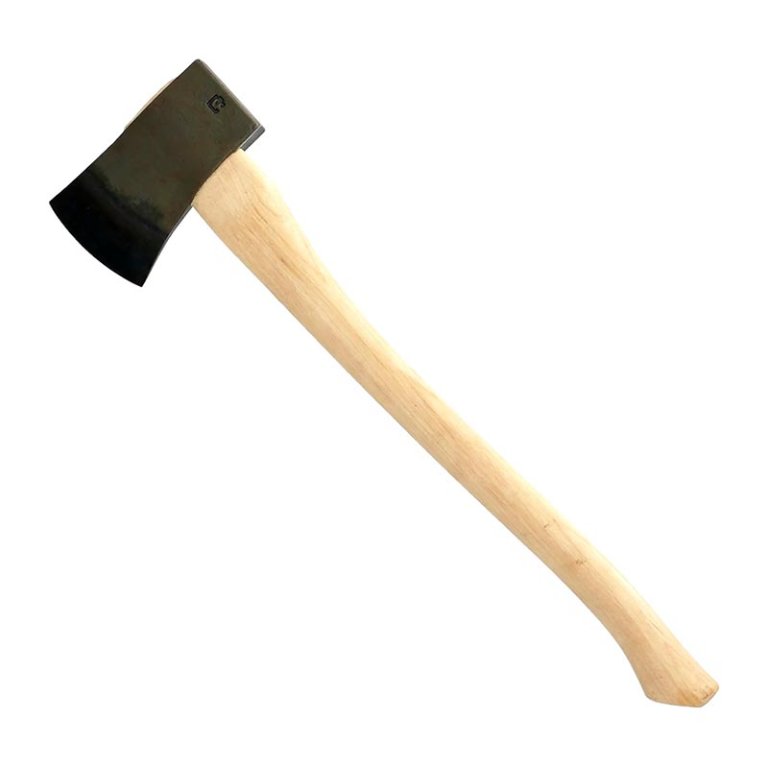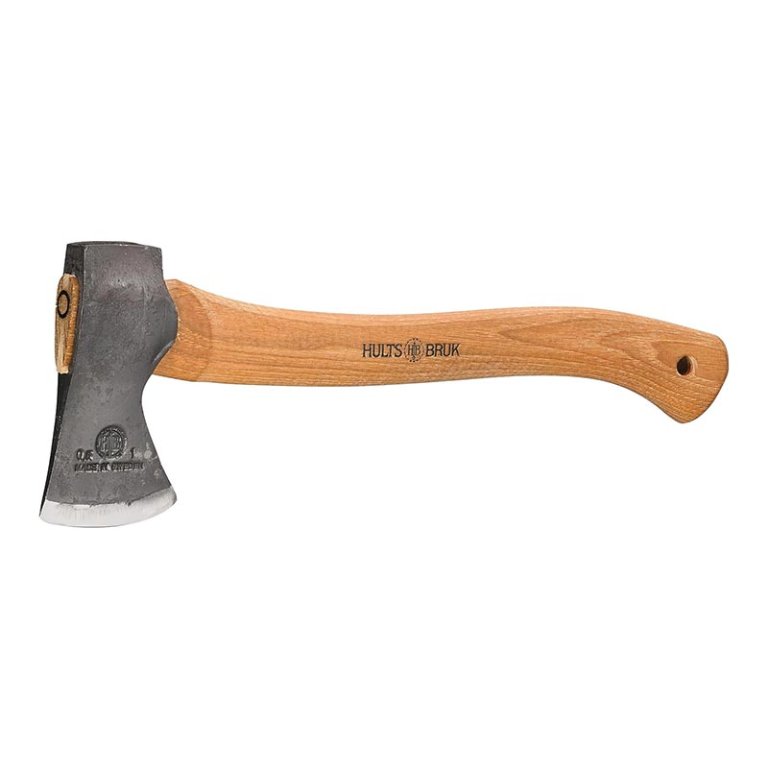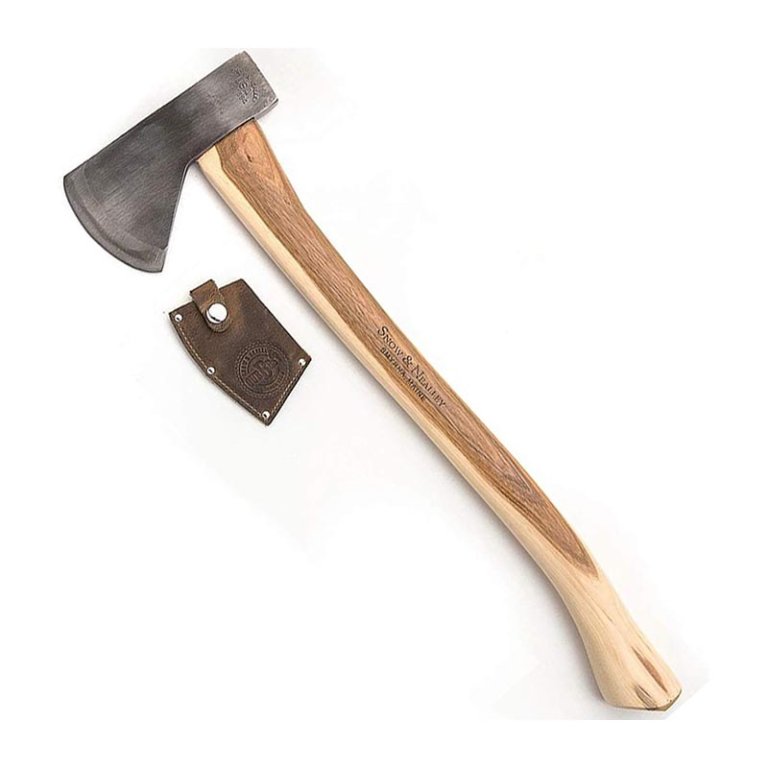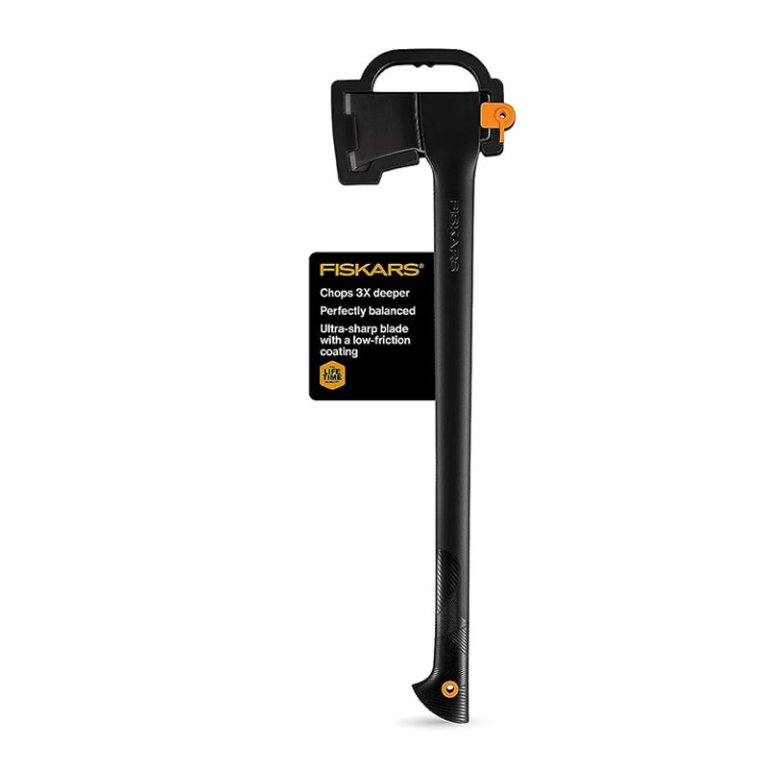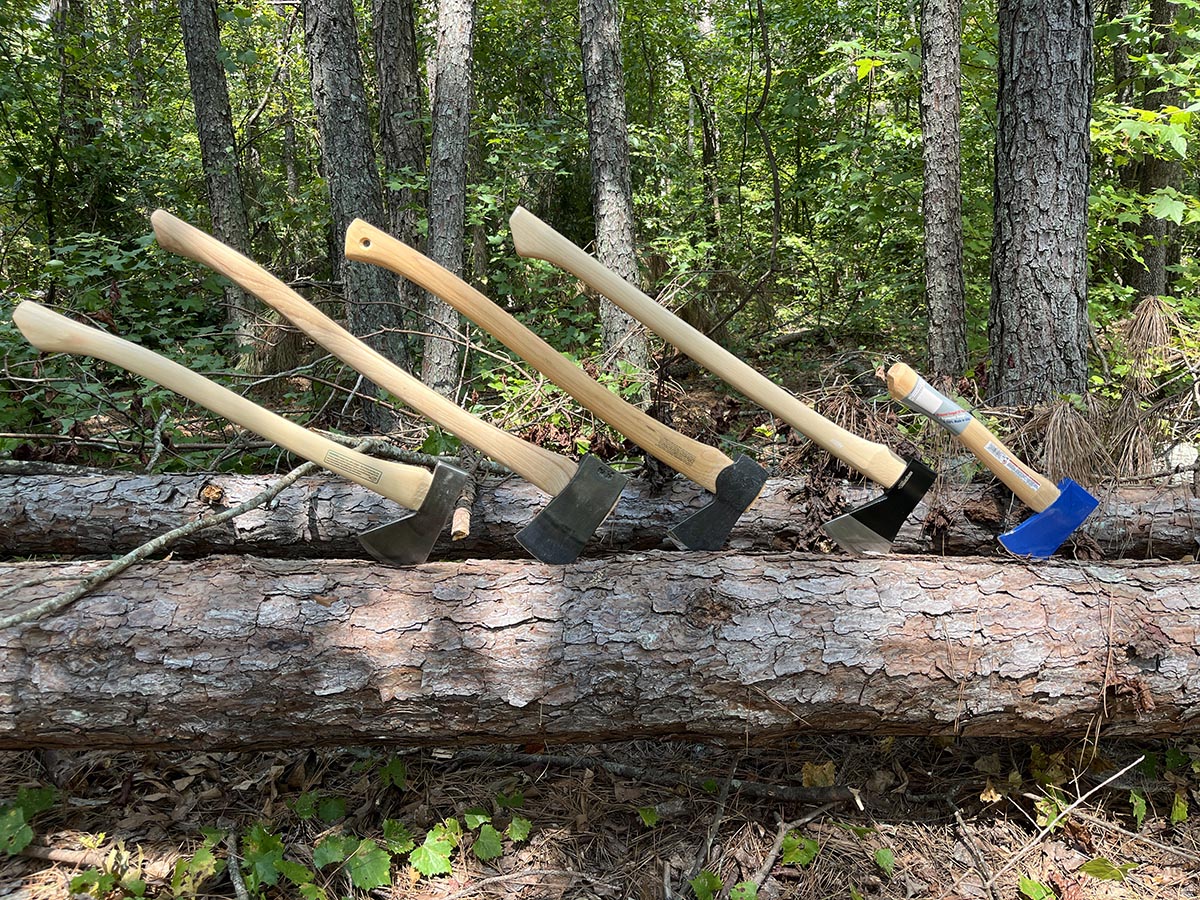
We may earn revenue from the products available on this page and participate in affiliate programs. Learn More ›
For cutting trees, splitting firewood, clearing brush, and woodcarving, a good axe is a must-have. These versatile tools come in many patterns and sizes. The weight and shape of the axe head, the curve of the bit (blade), the handle shape and length, and other design features help to determine the kinds of tasks for which a particular axe is best suited. For this guide, we spent more than 30 hours felling, chopping, and splitting as we tested 16 very different axes.
During testing, we focused our evaluations on a combination of quality, durability, performance, and value. Throughout testing, we were pleased with the quality and durability of all the axes, but our favorite was the Fiskars X27. We named it Best Overall because it splits wood more efficiently than lighter axes, weighs several pounds less than a splitting maul, and features a durable synthetic handle to withstand years of hard use. But not everyone needs a splitting axe, so we’ve included our top picks for a full range of outdoor chores. Whether you are looking for an axe for firewood, woodcarving, or other tasks, this guide will help you find the best axe for the job.
- BEST OVERALL: Fiskars X27 36-Inch Super Splitting Axe
↓ Jump to Review - BEST BANG FOR THE BUCK: Cold Steel 27-Inch Trail Boss Axe
↓ Jump to Review - BEST MULTIPURPOSE AXE: Gransfors Bruk Outdoor Axe
↓ Jump to Review - BEST SPLITTING MAUL: Fiskars Pro 36-Inch IsoCore Wood Splitting Maul
↓ Jump to Review - BEST FELLING AXE: Hults Bruk Kisa 26-Inch Felling Axe
↓ Jump to Review - BEST LIMBING AXE: Council Tool 24-Inch Boy’s Axe
↓ Jump to Review - BEST HAND AXE: Hults Bruk Almike 16-Inch Hatchet
↓ Jump to Review - BEST FOR CAMPING: Snow & Nealley Hudson Bay Axe
↓ Jump to Review - BEST FOR BEGINNERS: Fiskars 28-Inch Chopping Axe
↓ Jump to Review

Axes Comparison Chart
| Product | Length | Head weight | Handle material |
|---|---|---|---|
| Fiskars X27 36-Inch Super Splitting Axe | 36 inches | 6.3 pounds | Fiberglass composite |
| Cold Steel 27-Inch Trail Boss Axe | 27 inches | 1.8 pounds | Hickory |
| Gransfors Bruk Outdoor Axe | 14.6 inches | 1 pound | Hickory |
| Fiskars Pro 36-Inch IsoCore Wood Splitting Maul | 36 inches | 8 pounds | Fiberglass composite |
| Hults Bruk Kisa 26-Inch Felling Axe | 26.25 inches | 2 pounds | Hickory |
| Council Tool 24-Inch Handle Boy’s Axe | 27 inches | 2.25 pounds | Hickory |
| Hults Bruk Almike 16-Inch Hatchet | 16 inches | 1 pound | Hickory |
| Snow & Nealley Hudson Bay Axe | 23.25 inches | 1.75 pounds | Hickory |
| Fiskars 28-Inch Chopping Axe | 28 inches | 3.8 pounds | Fiberglass composite |
Our Top Picks
Unlike some of the newer, more technologically advanced demolition tools on the market, modern axes are the streamlined result of thousands of years of refinement by workers who depended on durable, efficient tools. For testing, we selected tried-and-true designs from highly rated tool brands. We evaluated performance, quality, and durability, and only the best axes made the final cut. Whether you need a specialized splitting axe or a general-purpose axe for camping or yard work, we’ve tested some excellent options.
Best Overall
Photo: AmazonWhat We Like
- Long handle enhances splitting momentum
- Head weight helps maximize effectiveness
- Sharp blade splits rounds easily
- Affordable price point
What We Don’t Like
- May be difficult for shorter users to use
- Requires strength and practice to learn to control
Product Specs
- Length: 36 inches
- Head weight: 6.3 pounds
- Handle material: Fiberglass composite
Our Ratings: Functionality 5/5; Durability 5/5; Value 5/5
For the power and velocity that only a long-handle axe can deliver, look no further than the Fiskars X27 Super Splitting axe. Measuring 36 inches long and weighing 6.3 pounds, this long-handled axe requires strength and coordination to swing, but once the blade strikes, it leaves a decisively powerful cut.
The Fiskars wood splitting axe doesn’t have a full maul head, but you can use the back side to drive a splitting wedge if needed. The handle, manufactured from a fiberglass composite, absorbs some of the shock of each strike, reducing wear and tear on your arms. It also has a slightly textured but comfortable feel and flared end to help maintain a firm grip.
During testing, this model performed beautifully. One of our testers owns an older model of the X27 that’s lasted 15 years despite regular use. This latest rendition felt just as good and didn’t disappoint.
What our tester says: “It’s a heavy axe that takes strength and skill to control. However, with a little practice, I found that the X27 could take on large rounds that other axes fail to tackle.”—Stacey L. Nash, Product Reviews tester and writer
Get the Fiskars X27 axe at Amazon, The Home Depot, Walmart, or Blain’s Farm & Fleet.
Best Bang for the Buck
Photo: AmazonWhat We Like
- Quality axe at an affordable price
- Lightweight head with a long bit
- Very sharp from the factory
- Fast cutting action for felling
What We Don’t Like
- Less momentum for splitting
- Varnished handle
Product Specs
- Length: 27 inches
- Head weight: 1.8 pounds
- Handle material: Hickory
Our Ratings: Functionality 4.7/5; Durability 5/5; Value 4.5/5
The Cold Steel Trail Boss proves that a good axe doesn’t have to cost a fortune. With its rugged yet lightweight build and multipurpose design, the 27-inch Trail Boss handles a wide range of felling, chopping, and splitting chores at a fraction of the price of many popular brands. It features a European felling-style axe head made of 1055 carbon steel, and a straight handle made of American hickory.
Overall, we liked the size and feel of this axe for general use. The moderate length is good for working among branches while clearing brush, and it still offers good swinging power and momentum. We found that splitting was best done on an elevated chopping block or from a kneeling position. It’s not the ideal pick for splitting cords of wood for home use, but it could be a perfect axe for camping as well as a handy brush-clearing tool.
The 1055 carbon steel axe head arrived sharp and held its edge extremely well throughout testing. The edge bevel was not too narrow or wide, making it ideal for felling, limbing, and bucking cuts. It had the longest cutting edge (4.5 inches from heel to toe) of all the axes we tested and just enough of a curved profile to boost efficiency. It bit deeply with each swing, and it did not have a tendency to get stuck in the wood.
Get the Cold Steel axe at Amazon, The Home Depot, or Cold Steel.
Best Multipurpose Axe
Photo: AmazonWhat We Like
- Perfectly sharp out of the box
- Lightweight and easy to swing
- Impressive quality and craftsmanship
- Head design allows for detail work
What We Don’t Like
- Much pricier than other options
Product Specs
- Length: 14.6 inches
- Head weight: 1 pound
- Handle material: Hickory
Our Ratings: Functionality 5/5; Durability 5/5; Value 5/5
Gränsfors Bruk enjoys a well-deserved reputation as a premier maker of axes and hatchets, and its lauded Outdoor Axe does the work of multiple types of axes. The tight-grained hickory wood handle is lightweight but feels stable and fits well in the hand. A lightweight 1-pound head may not sound like it would split well, but it’s deceptively sharp—so sharp, in fact, that if we rated it on a scale of 1 to 10 for sharpness, it would get an 11.
That sharpness plays into this axe’s true strength: fine detail work. The Gränsfors Bruk can function both as a traditional axe and a woodworking tool to carve and create furniture and art. During testing, the handle and head design offered excellent control, and the sharp head dug into the wood with every swing. We also tried it as a woodworking tool by scraping and carving a piece of wood. The head, which can be held in hand for better control when doing fine work, moved through the block of wood like soft butter. It’s a beautiful axe that makes others pale in comparison. However, the small size makes it better for splitting kindling than large rounds.
What our tester says: “It only took a few swings for me to fall in love with this axe during the testing process. It may come with a high price, but it outshines any of the other models we tested.”—Stacey L. Nash, Product Reviews tester and writer
Get the Gränsfors Bruk axe at Amazon, Lehman’s, Forestry Suppliers, or Gränsfors Bruk.
Best Splitting Maul
Fiskars Pro 36-Inch IsoCore Wood Splitting Maul
Buy at Amazon Buy at Tractor Supply Co. Buy at The Home DepotWhat We Like
- Heavy head splits large wood rounds
- Wide sledge for driving wedges
- Comfortable handle design reduces vibration
What We Don’t Like
- Excessively heavy head for most splitting
Product Specs
- Length: 36 inches
- Head weight: 8 pounds
- Handle material: Fiberglass composite
Our Ratings: Functionality 4.3/5; Durability 5/5; Value 5/5
Fiskars knows axes, and the IsoCore splitting maul can take on those large wood rounds that can make a wood splitting axe bounce like a rubber ball. A sturdy 36-inch handle made of a vibration-reducing composite keeps it comfortable while pounding through knots and other tough spots. If this maul doesn’t do the job, the next best option is a log splitter.
We used this axe for the most difficult tasks we could find. Even large rounds filled with knots and branches—rounds that typically require a chainsaw to split—were no match for this maul. The 8-pound head has a blade on one side and a sledgehammer on the other for splitting wedges. The sledge side is also nice and wide, making it easier to hit the target. Plus, the added weight of the head drives the wedge in deep for a better, faster split.
While its weight exceeds that of more comfortable 5- to 6-pound heads, that extra weight helps generate extra momentum on the downswing, and that momentum is exactly what is required for splitting hardwoods and large rounds. Just keep in mind that the weight is overkill for everything but the thickest, toughest, largest wood rounds. And it may be too heavy for those with limited upper-body strength.
Get the Fiskars IsoCore axe at Amazon, Lowe’s, Tractor Supply Co., The Home Depot, Walmart, or Fiskars.
Best Felling Axe
Photo: AmazonWhat We Like
- Lightweight axe head swings fast
- Unvarnished handle is pleasantly smooth
- Compact size makes it easy to pack
- Includes a sturdy leather sheath
What We Don’t Like
- Edge bevel may need to be adjusted
- Short cutting edge makes deep, narrow cuts
Product Specs
- Length: 26.25 inches
- Head weight: 2 pounds
- Handle material: Hickory
Our Ratings: Functionality 4.3/5; Durability 5/5; Value 4.5/5
If you’d prefer not resorting to a noisy chainsaw to take down small trees, a felling axe is a good alternative. A felling axe needs to dig deep into wood but doesn’t necessarily need the long handle of a splitting axe or maul. The Hults Bruk Kisa felling axe is a lightweight tool that excels at cutting trees and removing branches. It also serves well when splitting kindling for the fireplace or campfire.
The hand-forged Kisa felling axe is as beautiful as it is functional. The Swedish steel axe head boasts a rustic appearance with a heat-tempered and mirror-polished edge. The axe head is fitted on a traditional curved American hickory handle and includes a leather sheath. The unvarnished handle is a nice touch that should help prevent hand blisters with extended use.
Although the Kisa axe was one of the lighter axes we tested, it delivered excellent cutting force thanks to the short 3.25-inch cutting edge, which helps increase the axe’s velocity on the downswing. It made deeper and narrower cuts compared to axes with wider blades. The deeper cutting action allowed it to cut through trunks up to 10 inches in diameter and remove branches with fewer strokes.
We did note, though, that the factory edge bevel was coarser and less sharp on the Kisa axe than on several comparable axes. We had to tune up the edge before getting underway, but once we did that, it performed excellently. The wider grind allowed it to do some light-duty splitting in addition to its typical chopping duties.
Get the Hults Bruk Kisa axe at Amazon, Walmart, or Forestry Suppliers.
Best Limbing Axe
Photo: AmazonWhat We Like
- Multipurpose design for felling, limbing, and splitting
- Excellent factory sharpness
- Smooth unvarnished handle
- Good momentum for splitting
What We Don’t Like
- Heavier axe head
Product Specs
- Length: 27 inches
- Head weight: 2.25 pounds
- Handle material: Hickory
Our Ratings: Functionality 4.7/5; Durability 5/5; Value 5/5
Axes are grab-and-go and ready to work, which makes it super helpful to have one on hand if a tree comes down. We like the Council Tool Boy’s Axe design because its shorter handle and heavier Dayton-style axe head work to multiply cutting force where working space is limited, such as the tangled branches of a fallen tree.
This compact axe features a 2.25-pound head and a 24-inch handle, though the one we ordered actually measured 27 inches long. The head is coated with boiled linseed oil at the forge for protection against rust and corrosion, and the American hickory handle is sanded smooth and left unvarnished. It was sharp and ready to go right out of the box.
Unlike European-style axe heads, the Dayton pattern does not have a “beard,” so the weight is well balanced in the center of the cutting edge. The extra steel behind the heel area also makes it more durable. It delivered excellent power to efficiently cut through branches and trunks up to about 12 inches in diameter. It was a capable splitting axe for smaller rounds, although the handle length limits its practicality to smaller quantities of firewood.
Get the Council Tool axe at Amazon or Forestry Suppliers.
Best Hand Axe
Photo: AmazonWhat We Like
- Comfortable curved handle
- Excellent control without fatiguing
- Durable leather sheath
- Slight imperfections add character
What We Don’t Like
- Not efficient for large rounds
Product Specs
- Length: 16 inches
- Head weight: 1 pound
- Handle material: Hickory wood
Our Ratings: Functionality 4.7/5; Durability 5/5; Value 4/5
The Hults Bruk Almike hatchet provides splitting and chopping power in a small package. It also bears the Hults Bruk name, renowned for forging high-quality axes since 1697. This model features a 16-inch curved hickory handle with a tight grain that adds strength and beautiful oiling that preserves and protects the wood and adds visual appeal.
This model is incredibly comfortable in hand, and its svelte 1-pound head balances the design. Light enough for consideration as a backpacking axe, the combination of the handle design and head weight makes it easy to swing over and over again. Its sharp edge easily glides through wood, allowing for efficient splitting with minimal effort.
The ability of the Hults Bruk to split logs was surprising since hatchets aren’t usually the most efficient option for this task. Yet we also found its design highly effective for splitting and making kindling.
What our tester says: “I didn’t get tired when using it, and I got incredible accuracy with each swing. It’s on the pricey side for a hatchet, but it’s the type of tool that will get passed down and maintain its functionality.”—Stacey L. Nash, Product Reviews tester and writer
Get the Hults Bruk Almike axe at Amazon or REI.
Best for Camping
Photo: AmazonWhat We Like
- Lightweight packable design
- Long curved edge cuts efficiently
- Excellent factory sharpness
- Includes a leather mask
What We Don’t Like
- Less splitting momentum
- Varnished handle
Product Specs
- Length: 23.25 inches
- Head weight: 1.75 pounds
- Handle material: Hickory
Our Ratings: Functionality 4.7/5; Durability 5/5; Value 4.5/5
The best attributes of a quality camping axe are its packability and its versatility. The Snow & Nealley Hudson Bay Axe delivers both of these qualities at a high level. Whether it’s for car camping or packing into the wilderness, this axe’s compact, lightweight design makes it easy to bring along, and the head geometry suits a variety of chopping and splitting tasks.
The Hudson Bay Axe head is forged from 1080 carbon steel, and its curved handle is made of American hickory. We noted that the poll was about twice as deep as the other small axes we tested, which improves the balance. It comes equipped with a leather mask to protect the edge, along with the carrier.
Originally designed for trappers, hunters, and fishermen, the Hudson Bay Axe is well built for light to medium-duty felling and chopping, as well as light-duty splitting. It features a long, sharp cutting edge with a well-rounded profile that takes deep bites without lodging in the workpiece. The modest 24-inch handle and lightweight head make it easy to use one-handed, like a hatchet or hand axe, as the need arises.
Get the Snow & Nealley axe at Amazon, Lehman’s, or Forestry Suppliers.
Best for Beginners
Photo: AmazonWhat We Like
- Shock-absorbing handle with textured grip
- Length and balance for felling trees
- Low-friction head coating
What We Don’t Like
- More of a specialized tool; not as versatile
Product Specs
- Length: 28 inches
- Head weight: 3.8 pounds
- Handle material: Fiberglass composite
Our Ratings: Functionality 5/5; Durability 4/5; Value 5/5
The Fiskars 28-inch wood chopping axe’s durable fiberglass composite handle makes this one a great option for beginners. It is strong enough to withstand the occasional overswing while reducing vibration and absorbing the shock of each strike. Plus, the textured grip and flared handle end helped improve control.
This axe was a superstar during overall testing, but it really excelled when felling trees. For those times when a chainsaw isn’t at hand, a felling axe can make quick work of small trees. The Fiskars’ head-handle balance helped it stay in control and accurate while building momentum. The head dug into the wood, providing more progress with every strike. It’s also covered in a low-friction coating that makes it easier to pull the axe from the wood.
The protective sheath that comes with this axe locks in place, and we found that feature made it easier to store the axe without worrying that the cover would slip off. The sheath protected the head from nicking other items and kept the head from getting nicked or scratched by anything nearby. Our only issue with this model is that it’s very project and job-specific. The handle is a bit short for splitting, yet it’s too big for making kindling and limbing trees. But if you need an axe that can take down a tree, this is the right tool for the job.
Get the Fiskars chopping axe at Amazon, Walmart, or Fiskars.
Jump to Our Top Picks
How We Tested the Best Axes
| Testing Stats | |
|---|---|
| Products tested | 16 |
| Time spent testing | 30 hours |
| Tests performed | 6 |
| Price range | $50 to $210 |
Working with an axe can be tiring, but a well-designed tool makes that work more manageable. To assess the best axes, we scored each one on various metrics: performance and efficiency were crucial, of course, as was noting each axe’s handle length and head weight. These measurements play into an axe’s balance, which greatly influences how well and how long it can be used. We rated each axe for usefulness and whether we’d want to swing it again. Wrist fatigue also factored into the ease of use.
We evaluated each model using an established rubric, awarding points in various categories based on functionality, durability, and value. Given how many axes we tested, assigning each product a numerical rating in these categories really helped us see the forest for the trees, so to speak, and determine our standout picks. We used each axe to split at least five pieces of wood and make kindling with each one. If the axe had a specialty design, we also tested that axe within its specialty, such as felling trees or doing some woodworking.
| Product | Functionality | Durability | Value |
| Fiskars X27 36-Inch Super Splitting Axe | 5 | 5 | 5 |
| Cold Steel 27-Inch Trail Boss Axe | 4.7 | 5 | 4.5 |
| Gransfors Bruk Outdoor Axe | 5 | 5 | 5 |
| Fiskars Pro 36-Inch IsoCore Wood Splitting Maul | 4.3 | 5 | 5 |
| Hults Bruk Kisa 26-Inch Felling Axe | 4.3 | 5 | 4.5 |
| Council Tool 24-Inch Handle Boy’s Axe | 4.7 | 5 | 5 |
| Hults Bruk Almike 16-Inch Hatchet | 4.7 | 5 | 4 |
| Snow & Nealley Hudson Bay Axe | 4.7 | 5 | 4.5 |
| Fiskars 28-Inch Chopping Axe | 5 | 4 | 5 |
What to Consider When Choosing an Axe
Because axes are designed to perform a range of tasks, from felling trees and trimming branches to shaping wood for sculptures, they come in a variety of shapes and sizes. But not everyone knows that not all axes are suitable for splitting firewood. Splitting is the process of striking the flat sawed end of a short log to separate the wood fibers, which causes the log to split apart along its grain. The two main types of axes used to harvest wood are splitting and felling axes, and when you’re trying to split wood, you likely don’t want to use a felling axe. In a pinch, you can also split wood with a hatchet.
Type
- A splitting axe is sometimes referred to as a splitting maul, but splitting mauls are actually slightly different. A maul typically has a wedge-shaped head with a back side that looks like a sledgehammer. Most often, the blade side is adequate for wood splitting, but for a large log that’s a foot or more in diameter, the splitting power can be increased by positioning a splitting wedge—a long, narrow steel wedge—into the face of the log and using the maul end as a sledgehammer to hit it. (Check out step-by-step instructions for splitting logs.)
- A splitting axe features a large, heavy steel head (traditionally, these heads were made with iron) with a sharp, wedge-shaped blade that can split a log along the grain when struck decisively in the center. Splitting axes don’t have the “maul” side of the head, though they may have a flat side that can function as a hammer.
- A felling axe, also called a chopping or forest axe, has a lighter head than a splitting axe. These models are designed to chip away at a standing tree using horizontal strokes. When shopping for a splitting axe, steer clear of these axes because they’re not designed to split wood along its grain.
- A hatchet looks like an axe, except it has a shorter handle, usually 12 to 18 inches long. Hatchets are used for fine detail work, limbing, small splitting jobs, and sometimes felling small trees. They’re not necessarily great for splitting, but they can be used to make kindling or break apart smaller pieces of wood if needed.
Axe Handle
Splitting axe handles are made of one of three materials: hardwood, fiberglass composite, or forged steel that’s covered with rubber or a similar material.
- Wood axe handles are popular because they’re relatively lightweight and feel good to the touch. Wood also absorbs shock. On the downside, wood handles can weaken and break over time, requiring replacement. Wooden handles with a tight grain that runs parallel to the direction of the blade offer the best strength and durability.
- Fiberglass composite handles are smooth to the touch and will absorb some shock, but fiberglass has a tendency to shatter if used in subzero temperatures. It can also break if the user accidentally strikes the wood with the shaft, rather than the head.
- Steel axe handles are often forged in a single piece that combines both the axe head and the handle. These are the most durable choice, but they don’t absorb shock, so your hands may fatigue faster. Handles covered in rubber or a similarly absorbent material will reduce the shock that goes through your hands.
Length
When choosing an axe, the length of the handle is just as important as what it’s made from. Handle lengths run from 14 inches up to 36 inches. The longer the axe, the more velocity and power it can generate.
Just remember that hitting a precise spot on a log becomes slightly more difficult with a longer handle. Those just starting should consider an axe with a 31-inch handle. You may want to transition to a longer handle as your technique improves. Axes with shorter handles are often designed for use with one hand and are best for splitting kindling.
Weight
The heavier the axe head, the more power it can generate when swung in an arc and brought down onto the log. However, if the head is too heavy to control, it may throw off the aim and tire out the user after a few swings.
Standard splitting axes come with heads that weigh between 3 and 6 pounds. Mauls, which feature sledgehammer-type heads, can weigh as much as 8 pounds. Unless the plan is to compete in wood-splitting competitions, it’s usually best to go with an axe head that weighs 4 to 6 pounds. Hatchet heads are lighter, typically weighing between 1.5 and 3 pounds.
FAQs
A shiny new axe doesn’t come without a learning curve. If you’re new to splitting, you may have more questions. To make it easier, we’ve answered a few popular questions to ensure you’ve got the right axe for your needs and so that you know how to take care of it.
If you use the axe frequently, you may need to sharpen it regularly. Watch for signs of rust because nicks are fairly common. To prevent rust, oil the head before putting it in the sheath. Wood-handled axes may also need periodic oiling to maintain the strength and appearance of the wood.
Splitting mauls are generally larger and have a head that can act as a hammer or be hammered once it’s wedged in a large round. Splitting axes typically have sharper edges and don’t have the maul head. They might have a flat back side for hammering and a shorter handle. A splitting axe offers more versatility than a splitting maul if you need an axe for more than splitting. Hatchets are shorter than either splitting mauls or splitting axes. They’re easier to store and swing, so they’re a good choice if you only need to split occasionally.
If the only thing you’re doing is splitting, a splitting maul or splitting axe works best. Splitting mauls are more efficient for large rounds, but their weight and length require strength and practice. If you need an axe that’s close to a maul without the heavy maul head, take a look at the Fiskars X27 Super Splitting Axe. Splitting axes aren’t as efficient on large rounds, but they work well for splitting standard rounds, making kindling, and general-purpose use.
Expensive axes from reputable toolmakers often have a more refined fit and finish than cheaper ones, and they feature efficient head designs and sharper edges. They are often ready for work right out of the box. Cheap axes may be functional but less visually appealing, or may benefit from grinding or sanding to improve the blade geometry.
For best results, oil frequently and liberally at first, then annually. One tradition says to “oil it once a day for a week, once a week for a month, once a month for a year, and once a year thereafter.”
It’s a personal preference. Composite handles are maintenance-free and weatherproof, but often don’t feel as nice in the hand. Wooden handles, especially unvarnished, feel great but require care and some maintenance for longevity.
A heavier splitting axe can be better since it drives more force into the splitting action. However, the user’s skill and strength are part of the equation. Working with tools that are too heavy increases the risk of injury.
Meet the Testers
Stacey L. Nash has written about home and garden products, home design and decor, and general indoor and outdoor home improvement for 5+ years. She’s passionate about research and hands-on testing to find the products that add true value to homeownership and daily life. She lives on 12 heavily wooded acres, where she and her family put home and outdoor products to the test while avoiding bears and cougars.
Mark Wolfe is a product tester, writer, and twenty year green industry veteran. After decades of mowing, edging, planting, pruning, irrigating, and renovating landscapes, he now tests and writes reviews about the latest hand tools, lawn care products, outdoor power equipment, and other outdoor living goods.
Additional research provided by Glenda Taylor.
